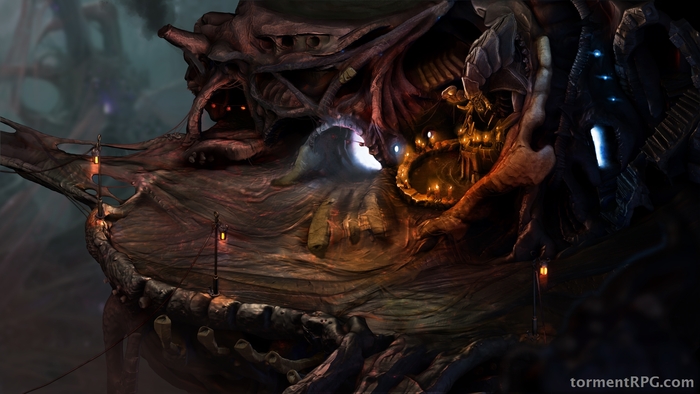It’s been a while since we had an update on the long overdue sequel to one of the classic RPG games of an era, Planescape Torment. The game was based on an enormously clever adaptation of the Advanced Dungeons & Dragons rule-set. Despite tremendous critical acclaim and a shelf of prestigious awards, however, the otherwise inevitable sequel was tragically precluded by the studio’s closure in 2003, consequent to financial difficulties over at parent company Interplay Productions.
Luckily for us they guys started a Kickstarter campaign and received a massive $4 million for the sequel, called Torment: Tides of Numenera. Having backed the project on kickstarter ourselves, we simply cannot wait for the release of this game. It is already deep into development and is expected to launch sometime next year.
Latest news is this interview held by IGN with the project lead, Kevin Saunders. We extracted some of the questions and answers here, but head over to IGN for the full interview, Torment – Tides of Numenera Update:

From “What can change the nature of a man?” to “What does one life matter?”. What kind of adventure is Tides of Numenéra?
Colin McComb, creative lead: It’s a philosophical journey through life, a search to find meaning in a world that is immeasurably ancient, where a human life passes in the blink of an eye. It’s a personal story, and we hope that it’s also one that will make an indelible impression on our players.
That’s the high-level, thematic concept. Beyond all that, we’re putting you in the place of the Last Castoff. You’ll be playing the game as someone who was born inside a body that has already been used. Your sire is the Changing God, a man who has cheated death by growing bodies and transferring his mind into them, casting those bodies aside when he has achieved his goals. You’re the latest – and the last – in the string of bodies he’s created to house himself. Your consciousness born when his fled your body, you awaken in a world that is immeasurably strange, where technology is so advanced that it seems like magic, where you might learn to control some of the fundamental forces of the universe. You might take a sentient, shape-shifting ball of goo as a companion, or a knave who can change her face with the touch of a button, or a warrior whose weapons change form to match his personality. You’ll travel through forests that devour cities, explore inside the guts of vast predators, traverse impossible deserts, and confront enemies inside a caldera once used to refine ores for spacecraft. It’s fantasy crossed with science-fiction crossed with the far reaches of the mind.
The player’s Will is one of the most important things in Tides of Numenéra. We have a world, characters and a story that respond organically to the player. Does this idea not conflict with your willingness to tell a story?
Colin: Well, we’re not making a sandbox game or an emergent narrative game – our game is in the tradition of Planescape: Torment and Mask of the Betrayer, which is to say a deeply personal exploration of a character that the player gets to define through his of her choices. Certain of those choices will advance the overall story of Torment, and the way the player makes those choices will allow us to react appropriately to the player’s actions.
That is, our game is a guided narrative, with significant reaction to the choices you make throughout the game. We’ll never be able to match a tabletop RPG for ease of adaptability to the players’ wishes, but we’re working hard to make sure we honor your choices in the context of the story you’ll experience.
How many different stories will we live as the Last Castoff? How long will Tides of Numenéra be?
Colin: The player will inhabit several different bodies in this game – but keep in mind that those experiences are more in the nature of vignettes or short stories, with a curtailed playing time, so they won’t make up the bulk of the game. They will, however, drive a number of choices and deliver specific information, and we hope that they’ll create a cool counterpoint to the main part of the game. It’s impossible to talk about length right now. Torment will be as long as it needs to be to tell the Last Castoff’s story. We will favor polishing the experience over adding filler content, because a shorter, more intense-but-fulfilling game is more in the spirit of Planescape: Torment. It’s also worth noting that the reactivity we are implementing increases the replayability of the game, rather than making it longer. We want this game to be something you can play again and again, and find delight in each time.

Did you expect this reaction of the fans when you founded the Kickstarter project?
Kevin: We did not expect the level of support we received from the fans. It was a great surprise. Overall, the community has been terrific. Before the Kickstarter, we were talking with the community and getting their input on what to have for rewards and pledge tiers – they helped us in designing the campaign. Throughout preproduction, we continuously receive ideas and thoughts through our forum and UserVoice site – we review these on a regular basis and consider the suggestions that we feel fit well within our vision for the game. We tend to have verbose, but infrequent updates, and the backers have been supportive of that – we appreciate their patience while we have concentrated on laying the groundwork for the game.
How has Kickstarter changed the original idea you had of Tides of Numenéra?
Kevin: Every once in a while, I’ll revisit the vision document we posted during the Kickstarter to see that we still have the same target. Over time, our vision has grown stronger and more detailed, of course, but it remains consistent with everything we had talked about back then. We spent considerable time prior to the Kickstarter to flesh out the themes, key story elements, and of course the Tides. I’m very glad we did that, as that foundation has served us well. We have had major changes to the story since the Kickstarter, but we revealed very little then, so no one would know. =) The brief synopsis Colin described in the pitch video still holds true. Our understanding of the game, the setting, and the characters increases daily as we delve deeper into the details and see pieces of it come to life. Our plans for the game have been evolving, but we’re remaining faithful to to the vision we laid out at the start.
Also See:




